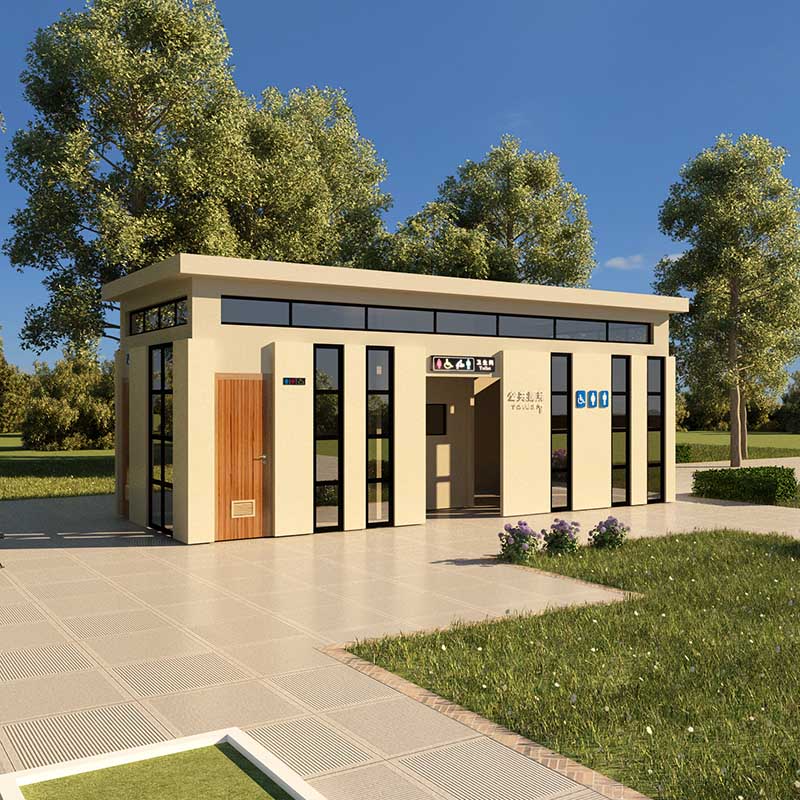Why Choose Light Steel Structure Public Toilet for Public Spaces?
2025-09-25
In recent years, the demand for sustainable, durable, and hygienic public sanitation solutions has significantly increased. Cities, parks, transport hubs, and event venues face challenges in providing accessible and long-lasting restroom facilities.
So, what exactly is a Light Steel Structure Public Toilet? It is a prefabricated, modular restroom facility built primarily with light steel framing. This construction method ensures a sturdy framework, corrosion resistance, and adaptability to diverse environments. Unlike traditional brick-and-mortar toilets, light steel structures can be assembled faster, maintained with minimal effort, and relocated when necessary.
Public health experts emphasize the importance of reliable sanitation in preventing disease spread. Local governments, developers, and facility managers are also under growing pressure to reduce costs, minimize construction timelines, and meet environmental goals. A Light Steel Structure Public Toilet addresses all of these concerns by combining speed of deployment with long-term durability.
Another major advantage lies in sustainability. Light steel is recyclable, and the prefabrication process generates less construction waste compared to conventional methods. In addition, these toilets can be designed with energy-efficient ventilation, natural lighting, and eco-friendly water systems, making them a smart option for communities focused on environmental responsibility.
Ultimately, a Light Steel Structure Public Toilet is not just about convenience; it reflects a city’s commitment to hygiene, safety, and innovation in public infrastructure.
How Does a Light Steel Structure Public Toilet Perform in Real-Life Applications?
Performance is the core factor that determines whether a public toilet truly meets the needs of a community. Light Steel Structure Public Toilets are engineered with features that enhance usability, hygiene, and safety in both urban and rural settings.
Here’s a closer look at the technical parameters and specifications that demonstrate their reliability:
| Parameter | Specification |
|---|---|
| Frame Material | Galvanized light steel, corrosion-resistant, high strength-to-weight ratio |
| Wall Panels | Sandwich panels or steel sheets with insulation for temperature stability |
| Roofing | Waterproof and fire-resistant steel panels with rainwater drainage system |
| Flooring | Anti-slip composite flooring, easy to clean, moisture-proof |
| Size Options | Customizable (2–10 units per block or larger modular combinations) |
| Doors & Partitions | Stainless steel or high-pressure laminate, vandal-resistant |
| Ventilation | Mechanical exhaust fans + natural airflow vents |
| Water Supply & Drainage | Pre-installed piping system with easy connection to local utilities |
| Electric System | LED lighting, energy-saving sensors, optional solar panel integration |
| Accessibility | Barrier-free entry, wheelchair access, optional baby-changing stations |
| Installation Time | 5–15 days depending on size and site preparation |
| Service Life | 15–25 years with routine maintenance |
This data highlights how Light Steel Structure Public Toilets go beyond being a quick solution. They are designed for resilience and capable of withstanding high-frequency use in demanding conditions.
Another performance highlight is hygiene control. Surfaces are non-porous, making them resistant to bacterial growth. Many models also integrate hands-free faucets, automatic flushing, and touchless soap dispensers. These smart features reduce cross-contamination, which is essential in crowded public areas.
In outdoor applications, weather resistance plays a vital role. Light steel frames are galvanized to prevent rust, while insulated panels protect against temperature extremes. This ensures year-round comfort whether installed in humid coastal zones, cold highlands, or urban heat islands.
From festivals to bus terminals, the flexibility of deployment means local authorities can scale sanitation capacity up or down according to seasonal demand. Unlike concrete structures, these units can be relocated, reused, or expanded, offering long-term savings.
Why Is a Light Steel Structure Public Toilet the Right Choice for Communities?
When evaluating investments in public infrastructure, decision-makers must balance cost, functionality, environmental impact, and user satisfaction. The Light Steel Structure Public Toilet meets these priorities in several compelling ways.
1. Faster Construction and Lower Cost
Traditional restrooms often require months of labor and expensive building materials. Light steel toilets are prefabricated in controlled factory settings, then assembled on-site in a fraction of the time. This streamlined process lowers labor costs, reduces project delays, and eliminates many of the unpredictable risks tied to conventional construction.
2. Long-Term Durability
Steel is inherently strong and resistant to termites, rot, and moisture. With proper galvanization and coatings, the lifespan extends well over two decades. Maintenance costs are significantly lower compared to wooden or brick-built toilets, which may require frequent repairs due to cracking or mold.
3. Environmental Responsibility
Public expectations for eco-conscious projects are rising. Steel is 100% recyclable, and many modular toilets incorporate water-saving devices, solar-powered lighting, and green insulation materials. This ensures municipalities can align with sustainable development goals without compromising on usability.
4. Enhanced Safety and Comfort
The inclusion of anti-slip flooring, proper drainage, and bright LED lighting ensures user safety. Adequate ventilation reduces odor buildup, while insulation makes the units usable in both hot and cold climates. Accessibility features also make these toilets inclusive for the elderly and people with disabilities.
5. Scalability and Flexibility
For growing urban populations or temporary events, scalability is critical. Units can be expanded by adding more modules or relocated as community needs evolve. This adaptability ensures the investment continues to provide value for years.
These benefits highlight why choosing a Light Steel Structure Public Toilet is not merely a cost-saving decision but a future-proof investment in public well-being and environmental stewardship.
How to Implement Light Steel Structure Public Toilets Effectively?
Implementation involves more than just choosing the right product; it requires thoughtful planning and execution. Here’s a step-by-step approach communities and developers can adopt:
Step 1: Site Assessment
Survey the proposed location to check for space, water, and power availability. Consider foot traffic patterns, environmental factors, and accessibility requirements.
Step 2: Design Customization
Decide on the number of units, layout, and additional features such as baby-care rooms, disabled access, or gender-neutral facilities. Customization ensures the toilet meets local cultural and regulatory standards.
Step 3: Utility Connection
Coordinate with local authorities to link the units to water supply, drainage, and power lines. In remote areas, self-contained options with solar panels and septic systems can be selected.
Step 4: Installation and Testing
Professional teams handle rapid assembly, followed by rigorous testing of plumbing, electricity, and safety features before opening to the public.
Step 5: Maintenance Plan
Schedule routine cleaning and inspections. The modular design makes it simple to replace individual panels, fixtures, or systems without dismantling the entire structure.
Step 6: Community Feedback
Collect user feedback to ensure satisfaction and identify areas for improvement. Public trust in infrastructure grows when people see their needs are heard and acted upon.
Through this structured process, communities can maximize the performance and life cycle of their sanitation facilities.
Frequently Asked Questions (FAQ)
Q1: How long does it take to install a Light Steel Structure Public Toilet?
A typical installation takes between 5–15 days depending on size, site conditions, and utility connections.
Q2: What makes a Light Steel Structure Public Toilet different from traditional toilets?
It is prefabricated, quicker to build, environmentally friendly, and offers flexibility for relocation and expansion, unlike traditional concrete-based restrooms.
Q3: How long can a Light Steel Structure Public Toilet last?
With regular cleaning and minimal maintenance, the service life can reach 15–25 years, providing long-term value.
The rising demand for efficient and sustainable sanitation facilities calls for innovative solutions that balance speed, durability, and eco-friendliness. A Light Steel Structure Public Toilet meets these challenges head-on, providing communities with hygienic, safe, and adaptable restrooms for the future.
From strong galvanized steel frames to customizable layouts and energy-saving systems, the benefits extend far beyond convenience. They represent a smarter investment for public institutions, developers, and governments seeking cost-effective infrastructure.
As one of the trusted providers in this field, Cymdin has established a reputation for delivering high-quality Light Steel Structure Public Toilets that align with international standards and client expectations. If you are planning to enhance your community’s sanitation facilities with a solution that blends innovation, sustainability, and durability, contact us today to explore the options that best suit your needs.





